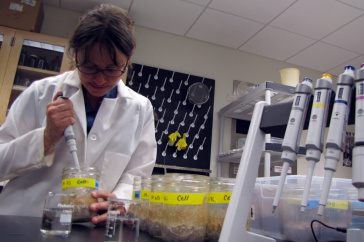The University of New Hampshire is a flagship research university that inspires innovation and transforms lives in our state, nation and world. More than 16,000 students from all 50 states and 71 countries engage with an award-winning faculty in top ranked programs in business, engineering, law, health and human services, liberal arts and the sciences across more than 200 programs of study. UNH’s research portfolio includes partnerships with NASA, NOAA, NSF and NIH, receiving more than $100 million in competitive external funding every year to further explore and define the frontiers of land, sea and space.
UNH Research Finds Microbial Traits, Not Plants, Determine Abundance of Soil Organic Matter

Cynthia Kallenbach, now at Colorado State University, found that soil organic matter accumulates from inputs of dead microbial cells and microbial byproducts formed when microbes eat plants, rather than from the plants themselves.
DURHAM, N.H. -- Healthy soil is rich in organic matter, but scientists have yet to fully understand exactly how that organic matter is formed. Now a team of University of New Hampshire scientists have uncovered evidence that microbial pathways – not plants – are the chief originator of the organic matter found in stable soil carbon pools.
In the paper, UNH scientists suggest that soil organic matter accumulates from inputs of dead microbial cells and microbial byproducts formed when microbes eat plant roots and residues, rather than from plants themselves, as previously thought. The new insight provides promise for designing agricultural systems that promote microbial communities to optimize soil organic matter formation.
The research was conducted by Cynthia Kallenbach, former UNH graduate student now at Colorado State University; her advisor, Stuart Grandy, associate professor of natural resources at UNH; and Serita Frey, professor of natural resources at UNH. Their results were published in the paper “Direct evidence for microbial-derived soil organic matter formation and its ecophysiological controls” in the journal Nature Communications.
In the past, scientists thought the best way to build soil organic matter was to slow down or inhibit decomposition using plants that soil microbes find difficult to decompose. The idea was that the undecomposed plant parts would gradually become soil organic matter, especially if the soil microbial community was inactive. However, this pool of soil organic matter, decomposing plant parts, doesn’t last long and can quickly disappear as carbon dioxide, sometimes within a year. This left the question of how to form pools of soil organic matter that persist for decades to help sustain healthy, productive soils.
Soil organic matter is a massive reservoir of carbon – containing more than twice as much carbon as there is atmospheric carbon dioxide. Thus, even relatively small changes in soil organic matter can have a large impact on atmospheric carbon dioxide, a critical greenhouse gas. Soil organic matter is also fundamental for plant growth and healthy agricultural systems.
“Soil carbon, in my mind, is the fulcrum around which all aspects of soil revolve,” Kallenbach said.
The UNH research paints a completely different pathway to building soil organic matter. This has been challenging for scientists to demonstrate, because once soil organic matter is formed, identifying whether it was most recently a plant or microbial cell is impossible.
In the lab, the scientists demonstrated the accumulation of significant amounts of chemically complex, persistent soil organic matter from microbial materials, in the absence of any plant inputs. Microbes unexpectedly produced soil organic matter that was almost identical to natural, field-derived soil organic matter when fed nothing but table sugar. Further, soil organic matter accumulation is greatest when more–not less–active microbial biomass is formed. This is especially true when that biomass is produced more efficiently, meaning more of the substrate is converted to biomass rather than carbon dioxide.
“Cynthia showed that the amount of organic matter formed depends heavily on the characteristics and physiology of the microbial community,” Grandy said. “Challenging another long-held view, Cynthia also found that the characteristics of the microbial community are even more important for soil organic matter formation than soil type.”
This material is based upon work supported by the National Science Foundation Doctoral Dissertation Improvement Grant (DEB-1311501) and the NH Agricultural Experiment Station through joint funding of the National Institute of Food and Agriculture, U.S. Department of Agriculture, under award numbers 1003421 and 1007001, and the state of New Hampshire.
Founded in 1887, the NH Agricultural Experiment Station at the UNH College of Life Sciences and Agriculture is UNH’s original research center and an elemental component of New Hampshire's land-grant university heritage and mission.
EDITORS AND REPORTERS: Cynthia Kallenbach can be reached at kallenbachcm@gmail.com.
-
Media Contact
Lori Tyler Gula, PhD | NH Agricultural Experiment Station | lori.gula@unh.edu | 603-862-1452
Latest News
-
March 12, 2025
-
February 19, 2025
-
February 6, 2025
-
February 5, 2025
-
January 15, 2025
















































